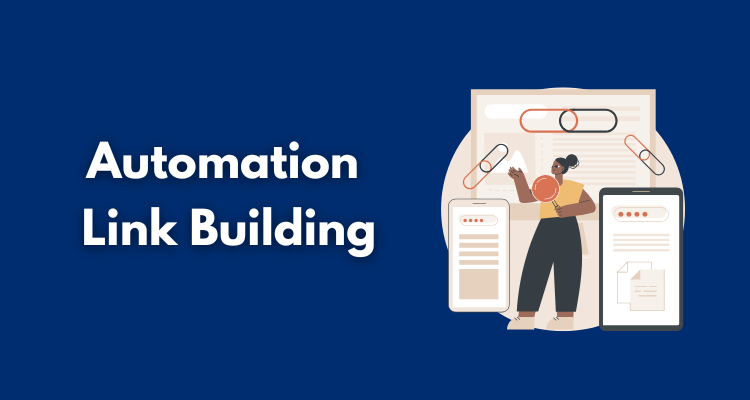Automated link building can feel like walking a tightrope. Do it right, and you’ll grow fast with powerful backlinks. Do it wrong, and Google may hit you with penalties that tank your rankings.
Then, how do you automate outreach without going too far? The key is intent, execution, and consistently delivering quality Link building. So, here is how you can create an automation workflow that does not raise alarm bells.
Table of Contents
ToggleBegin With High-Quality Content
Not sure what “high-quality” is? Keep in mind that you may get the audience through the door with automation, but your content makes them stay! A blog post, guide, or infographic should answer more questions than it raises and ease readers to the point where they feel so impressed they would like to cite it – that’s high-quality content.
Before a company even considers automation link building, they should ask themselves whether their content will be worth linking to. Mediocre content cannot be saved by automated outreach. Whether an ultimate guide, new statistics, or an exclusive idea, your backlink campaign subject must truly benefit the reader.

If not, then the rest of your automation engine is on such flimsy ground. The best assets are the starting point of the most successful automated campaigns.
Assets that provide value immediately serve as natural link magnets, with those opportunities being significantly more powerful on the outreach side.
Avoid Spammy Tactics
Scaling with templated outreach and cold emails may be appealing, but Google algorithms and your prospects can recognize spam from miles away. Avoid tactics like:
- Purchasing bulk links from sketchy directories
- Posting automatically in forums or blog comments
- Spamming email lists with identical pitches
This could be a win-win in the short term, but could cause damage in the long term. So you need to lose the focus on search volume, clicks, and cost per unique visitor and instead prioritize relevance, intention, and quality.
Spend your creativity towards creating something that answers an actual question, provides a solution, or presents a perspective.

This is especially effective when the content is evergreen, like industry benchmarks, detailed how-to guides, or case studies, because they can be referenced anytime. Incorporating visuals, such as infographics or your own original graphs, can also increase the likelihood of linking opportunities. That is because this content is often more appealing to link with, as it is more verbose and illustrative.
That said, establish internal limits, even when using automation platforms. Also, implementing a content approval workflow for emails is a must. This is to help make sure your email templates are never sent live without approval.
Also, conducting periodic quality assurance checks to ensure your templates haven’t crept into the “spammy” zone over time can go a long way in maintaining your deliverability. You would also want to make it a point to review bounce rates and spam complaints occasionally to be sure you haven’t strayed over that line without knowing it.
Choose Tools That Allow Smart Personalization
Automation has many advantages, but nothing good will come out of it if the entire experience looks identical. Utilize dynamic field insertion tools, smart text blocks, and personalized logic to make the best of automation.
A great software will enable you to customise subject lines and email bodies with particular details about every client. When your outreach emails are sent in bulk, addressing their recent blog post or relating your pitch to their industry, it creates a sense of personalization.
That being said, Pitchbox, Mailshake, and BuzzStream are among the best tools for personalization. They enable you to build CRM-like segmentation, email A/B testing, and behavioral triggers.
Personalize not only by first name but also by their content themes, audience interests, or how your email references the publication’s tone. Automation is only effective when it scales human interaction, which involves some premeditated consideration.
Segmenting and Prioritizing Your Prospects
Please do not shovel 1,000 sites in your campaign. Segment based on authority, relevance, and engagement history. Focus on:
- Websites within your industry or vertical
- Websites that have previously linked to related content
- Contacts that are active and respond
A short, well-focused list will always be better than a long, messy one. Apply filters that differentiate domains with high authority and those with low trust. You can set up custom buckets, such as ‘Top Tier Editors’, ‘Niche Bloggers’, ‘Resource Page Managers’, etc.
This enables you to create better-targeted emails for every segment. You can also check historical open rates and reply trends to give you an idea of whom to prioritize. This results in efficient outreach and helps increase the campaign’s return on investment.
Manual Review + Automation

The story isn’t foolproof, so build gateposts for humans to step in on your campaign. Before launching, examine prospect lists—authorization of email templates and editing help to handle nuanced replies or tricky text. Executing this hybrid approach maintains low risk and high quality.
There are moments when your team should step in, such as before you send a campaign, after the initial blast of emails, and when replies come in. Automation is great for scheduling and sending those emails.
Strictly Adhere to Google’s Guidelines
Google has always been straightforward about link schemes and what is manipulative. Read the guidelines and make sure to avoid:
- Overuse of exact-match anchor text
- Exchanging links or providing incentives
- Building thin content purely for the sake of backlinks
What you automate should amplify value. If the link does not make sense without the value of SEO, that violates a guideline. A good rule of thumb: With every link you build, your aim should be for the reader to gain a positive experience.
So, would you still have dropped that link if it was not influential ranking-wise? If not, rethink the strategy. Adhering to a set of rules is good; it allows you to build a sustainable, reputable SEO footprint that stands on principles, and that’s what you get with Google’s guidelines.
Monitor Link Velocity
Getting too many links too soon can set off alarm bells. Over time, a backlink profile grows gradually. Using your tools, keep tabs on how many links you get a week or a month. If all these indicators are going up rapidly, stop and think again. Stagger your campaign timetables and give them time to rise organically.
Many SEOs fall into this trap: after gaining some early traction, they crank up the campaigns aggressively. Nevertheless, high-speed link building can set off spam detection systems, primarily when associated with the exact anchor text or referencing domains.
Space out your outreach waves and even limit your follow-ups. This allows you to avoid penalties and better understand the messaging that resonates the best.
Always Track the Quality of Your Domains
The web changes fast. What was a fantastic domain last month could be spammy today. Monitor domain authority, trust flow, and spam scores with tools like Ahrefs or SEMrush. Create alerts if connected sites decline in quality. Get rid of your worst links or disavow them before they hurt your profile.
Constructing a dashboard consolidating the link well-being measurements at a weekly or monthly interval is also clever. Create separate columns for domain rating, type of link (dofollow/nofollow), diversity of anchors, trust score, and so on.
Act whenever you notice a trend of backlinks from low-quality sites. Use the Disavow Tool from Google to disavow toxic links, be proactive, and avoid penalization.
Focus on Building Relationships
Automation doesn’t equal depersonalization. So get on social media, bombard clients with comments on their posts, and develop a real reporter/publisher relationship. A warm intro will always beat a cold pitch, even if it is automated.
Consider automation as an assistant, not a replacement. Utilize it for the grunt work, such as follow-ups and data entry, leaving you to attend to meaningful, human interaction.
Keep in touch with your best prospects on LinkedIn, Twitter, or with a newsletter. These warm touchpoints increase the chances of your email being opened, read, and acted upon.
Audit Your Backlink Profile Timely
Conduct link audits every month. Check for:
- Toxic links
- Broken or removed backlinks
- Overused anchor texts
Fix issues early. Putting off handling bad links increases the risk of penalties, amplifying with time. The link audit also provides insight into the best backlinks that provide relevant traffic to your website. Leverage this information to enable you to narrow your outreach targeting.
Be careful about abnormal anchor patterns or linkbacks too concentrated for one URL or keyword. The link profile of any domain needs a healthy mix to avoid looking unnatural.
Final Thoughts
While automation is a great ally, it must be wielded with moderation. Great content, smart targeting, and the right level of personalization are the foundations of the best automation campaigns. Forget shortcuts; create real value.
Using AI efficiency and human wisdom, your automated link building can remain pure, trustworthy, and penalty-proof. Algorithms are becoming more intelligent, but so are the users, and both expect to see realness. Properly executed automation does not replace effort; it enhances effort.









